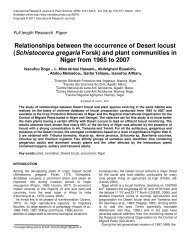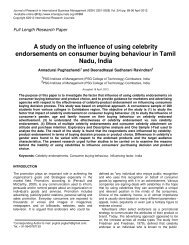Antibacterial and antifungal activities of Cestrum parqui saponins ...
Antibacterial and antifungal activities of Cestrum parqui saponins ...
Antibacterial and antifungal activities of Cestrum parqui saponins ...
Create successful ePaper yourself
Turn your PDF publications into a flip-book with our unique Google optimized e-Paper software.
006 Int. Res. J. Plant Sci.<br />
They showed that incubation <strong>of</strong> digitonine (steroidic<br />
saponin with five sugars) with biological membranes<br />
caused their deformation (Miller, 1984; Augustin et al.,<br />
2011). Other works showed that the same substance can<br />
act on artificial lipidic vesicle which can cause the rupture<br />
<strong>of</strong> the membrane <strong>of</strong> the vesicle containing cholesterol,<br />
whereas the membranes free from cholesterol remained<br />
undamaged (Menger <strong>and</strong> Keiper, 1998).<br />
The glycoalkaloidic <strong>saponins</strong> extracted from the<br />
Solanum genus have the property to cause the<br />
membrane rupture <strong>of</strong> the liposomes (Roddick et al.,<br />
2001). Moreover, 15 triterpenic <strong>saponins</strong> extracted Aralia<br />
genus exhibited similar activity with more or less<br />
significant degrees (Hu et al., 1996). Saponins can also<br />
permeabilize Penicillium simplicissimum membrane (Liu<br />
et al., 2011b).<br />
The avenacin A1, which is a triterpenic saponin, can<br />
significantly modify the permeability <strong>of</strong> the double artificial<br />
membrane lipidic layer. This disturbance occurred only if<br />
the double layer contains cholesterol (Armah et al.,<br />
1999). Commercial glycoalkaloids (α-solanine, αchoacine,<br />
<strong>and</strong> α-tomatine) destroyed the membrane<br />
structure <strong>of</strong> artificial lipidic vesicle. This activity is lost by<br />
the elimination <strong>of</strong> one or more sugars from the initial<br />
molecule (Keukens et al., 1995).<br />
This assumption <strong>of</strong> cytotoxicity is generally maintained<br />
in the case <strong>of</strong> fungal cells (Morrissey <strong>and</strong> Osbourn,<br />
1999). The present study revealed the loss <strong>of</strong> the<br />
<strong>antifungal</strong> potential <strong>of</strong> C. <strong>parqui</strong> <strong>saponins</strong> subsequent to<br />
the addition <strong>of</strong> cholesterol in the culture medium <strong>of</strong> T.<br />
viride already supplemented with CSE.<br />
Saponins are relatively massive molecules which<br />
contain sugars with easy degradation under certain<br />
condition (pH slightly acid or basic, presence <strong>of</strong><br />
enzymes...). This degradation leads to the loss <strong>of</strong> the<br />
activity which enormously depends on the water-soluble<br />
sugar chains. The modification <strong>of</strong> the structure <strong>of</strong> C.<br />
<strong>parqui</strong> <strong>saponins</strong> by the separation <strong>of</strong> the aglycone/sugar<br />
by a hydrolysis reaction also led to a loss <strong>of</strong> the fungicidal<br />
activity <strong>of</strong> those molecules as noted in the present study.<br />
These findings are in agreement with those obtained by<br />
several authors (Takagi et al., 1982; Keukens et al.,<br />
1995; Armah et al., 1999).<br />
Keukens et al. (1995) showed that the reduction <strong>of</strong> the<br />
chain <strong>of</strong> α-tomatine or <strong>of</strong> α-choacine resulted in a total<br />
loss <strong>of</strong> their activity on the membrane rupture. In the<br />
same way, a study focused on the digitonine/cholesterol<br />
interaction showed that digitonine analogues could be<br />
complexed with cholesterol. Various degrees <strong>of</strong><br />
glycosylation <strong>of</strong> the digitonine were used where two, four<br />
or five sugars were associated to aglycone. The results<br />
showed that this complexation increases when the<br />
number <strong>of</strong> associated sugars increases (Takagi et al.,<br />
1982). Recently, it was demonstrated that α-tomatine<br />
induces apoptosis in Fusarium oxysporum (Ito et al.,<br />
2007).<br />
Hu et al. (1996) <strong>and</strong> Armah et al. (1999) found, by<br />
using similar <strong>saponins</strong> having the same triterpenic<br />
aglycone, that the nature <strong>of</strong> sugar influences little the<br />
general activity <strong>of</strong> the molecule but that, on the other<br />
h<strong>and</strong>, the hydrolysis <strong>of</strong> one or two or three sugars<br />
induces the total or the partial loss <strong>of</strong> the inhibitory<br />
activity.<br />
The partial hydrolysis <strong>of</strong> the sugar chain seems to be<br />
a strategy <strong>of</strong> detoxification <strong>of</strong> <strong>saponins</strong> by the<br />
phytopathogenic fungi. These micro-organisms are able<br />
to secrete hydrolyzing enzymes inducing loss <strong>of</strong><br />
saponin’s activity by the elimination <strong>of</strong> one or more<br />
sugars <strong>of</strong> the chain in C3 (Morrissey <strong>and</strong> Osbourn, 1999).<br />
It seems, also, that the aglycone itself plays a role in the<br />
total activity <strong>of</strong> <strong>saponins</strong> since a modification <strong>of</strong> the<br />
aglycone provokes the change <strong>of</strong> the membrane activity<br />
<strong>of</strong> glycoalkaloidic saponin analogues <strong>of</strong> Solanum species<br />
(Roddick et al., 2001).<br />
The <strong>antifungal</strong> activity <strong>of</strong> <strong>saponins</strong> <strong>of</strong>fers a real<br />
important alternative for the management <strong>of</strong> plant<br />
pathogenic fungi. In fact, recently, tea <strong>saponins</strong> were<br />
used successfully to manage green <strong>and</strong> blue moulds in<br />
citrus orchards (Hao et al., 2011). In the same way,<br />
Quillaja saponaria Molina, Yucca schidigera Ortgies <strong>and</strong><br />
Balanites aegyptiacus (L.) Delile, <strong>saponins</strong> have<br />
exhibited important fungicidal effects against Pythium<br />
ultimum, Fusarium oxysporum, Alternaria solani,<br />
Colletotrichum coccodes, <strong>and</strong> Verticillium dahliae<br />
(Chapgain et al., 2007). Several researches try to<br />
synthesize saponin molecules exhibiting fungicidal effects<br />
<strong>and</strong> recently, commercial saponin extracts were used for<br />
their inhibitory <strong>activities</strong> against Sclerotinia sclerotiorum,<br />
Rhizoctonia solani, Botrytis cinerea <strong>and</strong> Phytophthora<br />
parasitica (Zhao et al., 2011). Thus, further researches<br />
are needed for the assessment <strong>of</strong> <strong>saponins</strong> from other<br />
local plants for their better valorisation as potential<br />
sources <strong>of</strong> biologically actives compounds.<br />
CONCLUSION<br />
The present results demonstrate that <strong>saponins</strong> extracted<br />
from <strong>Cestrum</strong> <strong>parqui</strong> do not have any antibacterial activity<br />
against all the bacterial strains tested (Pseudomonas<br />
aeruginosa, Escherichia coli, Staphylococcus aureus <strong>and</strong><br />
Enterococcus faecalis) even with the highest CSE<br />
concentration used (100 mg/ml) probably due to the<br />
absence <strong>of</strong> sterols in their membranes as recorded in the<br />
following biological tests. In fact, <strong>saponins</strong> do not exhibit<br />
any inhibitory effect against the two phytopathogenic<br />
fungi tested probably due to their ability to synthetize<br />
detoxification enzymes. However, the antagonistic<br />
fungus Trichoderma viride was found to be sensitive to<br />
<strong>saponins</strong> (IC50= 210 ppm). The activity in relation with<br />
sterol presence in target agent membrane was also<br />
demonstrated. The <strong>antifungal</strong> activity <strong>of</strong> <strong>saponins</strong> can be<br />
more deeply studied in order to determine other sensitive<br />
pathogenic fungi which may be controlled by using these<br />
<strong>saponins</strong>.














